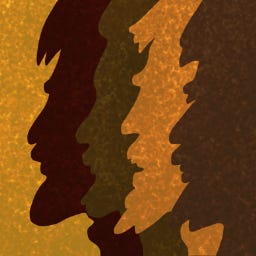The Brothers Karamazov: We Begin Reading Book 3 The Sensualists
In this article, you will find a bookmark, information about the city, and key points to start reading, without spoilers for the Book 3 itself
Hello!
Finally, we begin reading the third book of The Brothers Karamazov novel. This book completes the first part (books 1-3).
All materials and schedule can be found here
Let's quickly recall what happened before
Book One introduced us to the Karamazov family through a brief, incomplete biography. We still don't know about the parents' backgrounds or how Fyodor Pavlovich, the family patriarch, was raised—nor do we know about our brothers' grandparents.
For more detailed chapter-by-chapter content, you can refresh your memory here
Book Two marks the beginning of the novel's central conflict—primarily the confrontation between the father and his eldest son. This setup explores the relationships between the brothers, introduces love triangles, and examines their connections to both worldly and spiritual matters. The second part culminates in a family gathering at Elder Zosima's hermitage, where they attempt to resolve an inheritance dispute. However, as we've seen, the relatives have far deeper reasons for their discord.
For more detailed chapter-by-chapter content, you can refresh your memory here
Book Three - The Sensualists
In the third book, the title of Chapter 9 matches the title of the entire book—this must be significant. In Russian, the chapter is called "Сладострастники" (Sladostrastniki), which refers to people prone to sensual pleasure, voluptuousness (for me it is the closest to сладострастие (sladostrastie). This trait—perhaps a sin—is portrayed as fundamental to the Karamazov family. Now is the time to recall Rakitin's conversation with Alyosha in Chapter 2.7, where he accused even Alyosha of this vice.
The novel, therefore, centers on conflicts involving women and the struggles surrounding them. Two love triangles have already emerged:
Grushenka - Dmitri - Fyodor Pavlovich
Agrafena—known to all as Grushenka—is a young woman of questionable reputation. Fyodor Pavlovich Karamazov is infatuated with her, eagerly awaiting her visit to his house. His son Dmitri, equally passionate about Grushenka, is consumed by jealousy toward his father. This jealousy drives him to reckless behavior. In the third book, we'll explore this triangle further, seeing how the Karamazovs behave and hearing Grushenka's own perspective when we meet her.
The second triangle, still emerging in the background, centers on Katerina Ivanovna, Dmitri's fiancée. We'll meet her toward the end of the third book.
Setting
The third book is shown through Alexei's journey. The narrator continues to tell us about past and present events, particularly about the birth of Smerdyakov—also one of the main characters of the novel. I won't write about his biography yet.
But in the third book, we follow Alexei's footsteps with the narrator: how he leaves the monastery for the city, where he meets his brother Dmitri, visits his father's house, makes his promised visit to Katerina Ivanovna, and returns to the monastery. Therefore, Alexei is present in all chapters of the current story.
Timeline
This is the end of the first day of the narrative. From about 2 o'clock in the afternoon, when everyone dispersed after the scandal at the monastery, until night, when after his "journey to the city" Alexei returns to Zosima's cell.
The City and the Karamazovs' House
The events in the novel take place in a fictional city that hasn't been named in the text yet, but its name is Skotoprigonyevsk. Dostoevsky didn't invent or develop it from scratch, but based it on the real city of Staraya Russa, where he had a house and where he wrote the novel. Dostoevsky always worked this way—he didn't spend time and effort developing the surrounding world, instead using existing "scenery" as his foundation. This allowed him to easily describe the paths, characters' walks, landscapes, and houses. He copied all of this from reality.
In Staraya Russa today, there is a museum dedicated to the novel, as well as Dostoevsky's museum in the very house that is believed to be described in the novel as the Karamazovs' house. Although there are some discrepancies in the description of the house itself, its location should be in that place.
I want to show you a map that is displayed in the Dostoevsky Museum as the map of Skotoprigonyevsk. It's called In the City of the Brothers Karamazov.
F.M. Dostoevsky's House (i.e. the Karamazovs' House)
Priest Rukhitsev's House on Pyatnitskaya Street
Ilyinskaya Street
Staraya Russa. General view (beginning of Pererytitsa embankment)
Geneva Gymnasium
Grushenka's House
Resurrection Cathedral
Trading Rows (Plotnikovs' shop)
Resort - library balcony
Resort Theater
Dostoevsky School
Georgievskaya Street and Church of the Holy Great Martyr Mina
Krestetskaya Street
St. George's Church from the Malashka River bank
Krestetskaya Street
Vladimir Church
Dmitrievskaya Street
Dmitrievsky Lane
Spaso-Preobrazhensky Monastery
In this case, we are interested in numbers 1 and 6: the Karamazov House and Grushenka's House.
Dostoevsky's House (as it was in the 19th century and how it looks now as a museum).
Grushenka's House, which bears a plaque reading: "In this house lived Agrippina Menshova - the prototype of Grushenka Svetlova in the novel The Brothers Karamazov."
If you'd like to "walk around" Dostoevsky's/the Karamazovs' house and its modern museum, I suggest watching this short YouTube video. The narrator speaks Russian, but you can turn on English subtitles, or simply watch without sound, as the narrator mostly describes what can be seen in the video.
You can download the bookmark I prepared for you, which lists the characters who are important specifically for the third book, as well as the chapter list. And a second version with the dates of our discussions.











Fyodor Pavlovich needs Grigory’s protection, but from whom? Who is that “dreadful and dangerous” someone? There must be clues onward. Dostoevsky is too careful with his words for this to be unimportant.
Thanks for the introduction and the video - I enjoyed listening to the narrator ...